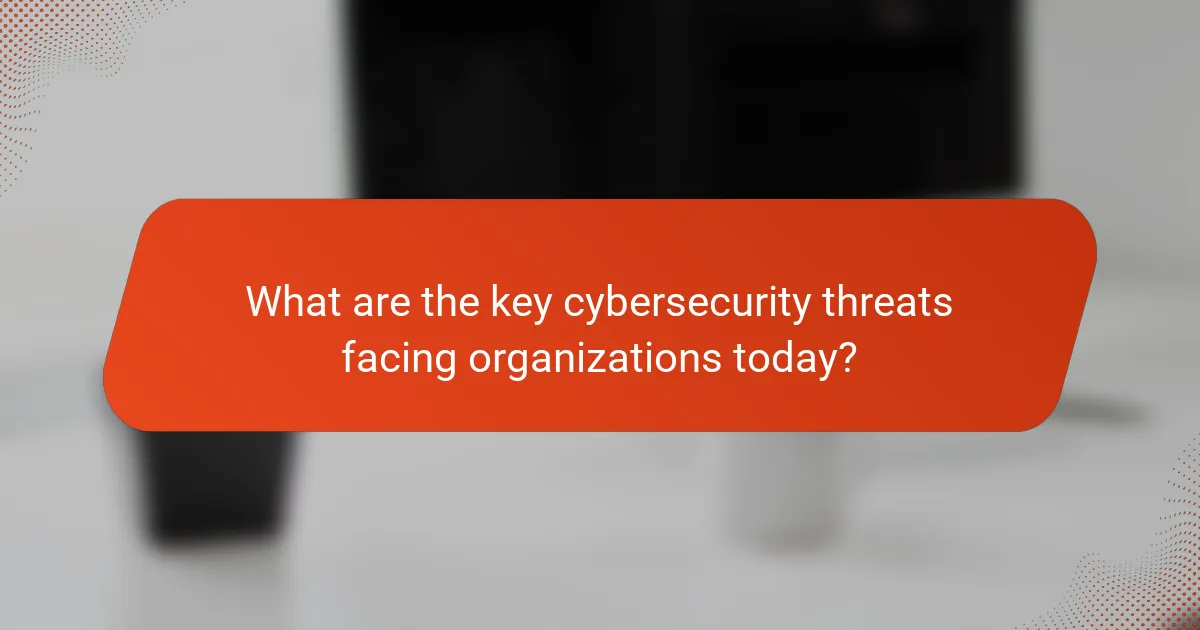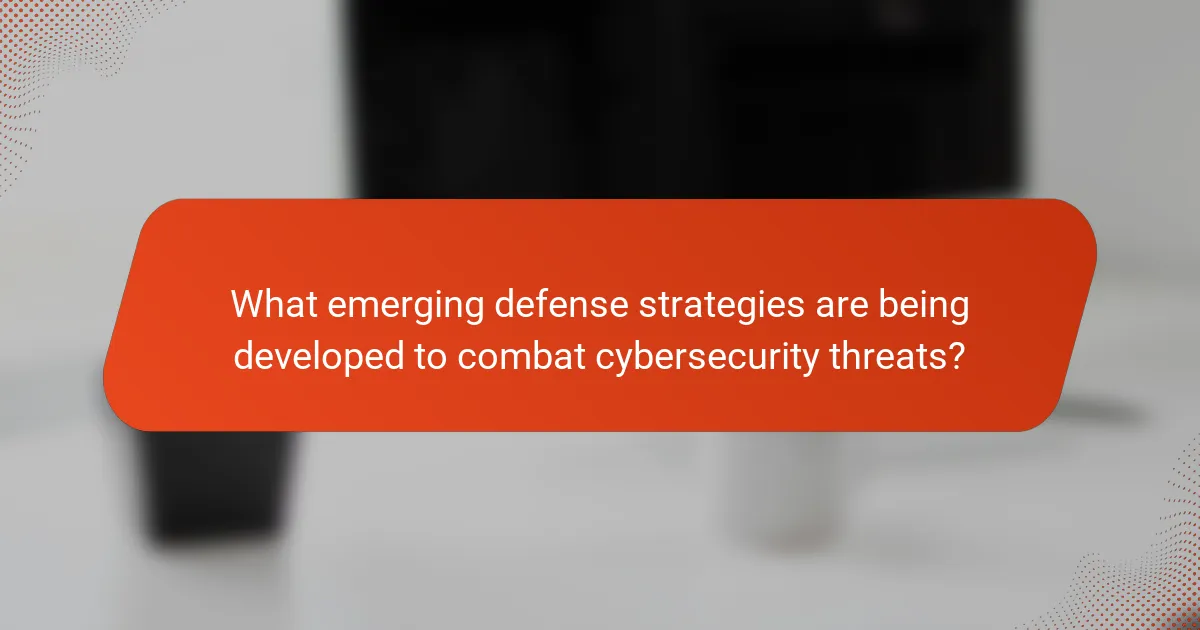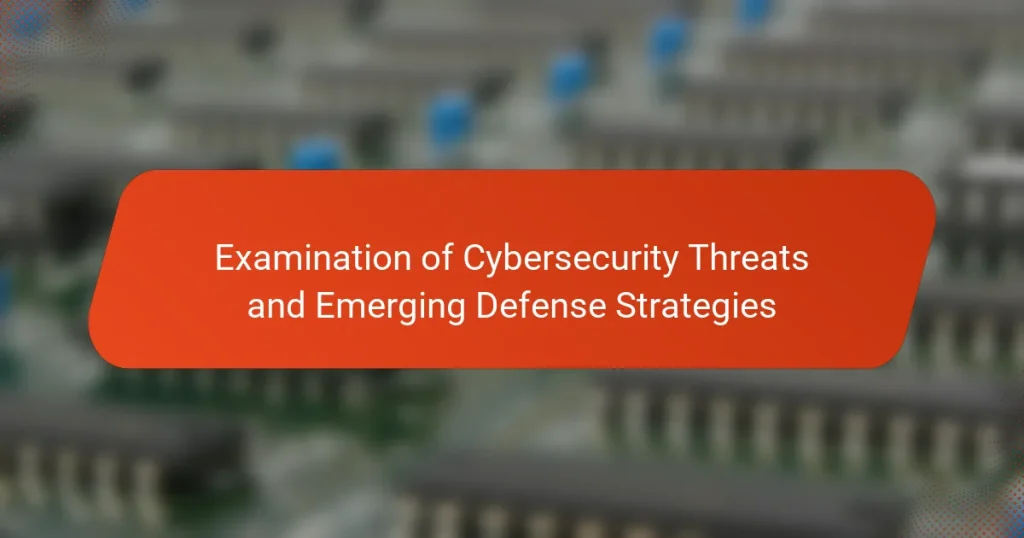Cybersecurity threats are critical challenges for organizations, with key threats including ransomware, phishing attacks, and insider threats. Ransomware involves malicious software that encrypts data for ransom, while phishing attacks deceive individuals into disclosing sensitive information. Insider threats stem from employees misusing their access to data, resulting in significant financial losses. To combat these threats, organizations are increasingly adopting advanced defense strategies such as artificial intelligence, machine learning, zero-trust architecture, and automated incident response systems. Additionally, regular assessments through risk evaluations and security audits are vital for strengthening cybersecurity postures and minimizing vulnerabilities.

What are the key cybersecurity threats facing organizations today?
Key cybersecurity threats facing organizations today include ransomware, phishing attacks, and insider threats. Ransomware attacks involve malicious software that encrypts data, demanding payment for decryption. According to Cybersecurity Ventures, ransomware damages are projected to reach $20 billion in 2021. Phishing attacks trick individuals into revealing sensitive information, often through deceptive emails. The Anti-Phishing Working Group reported over 200,000 phishing attacks per month in 2020. Insider threats arise from employees or contractors misusing access to data. The Ponemon Institute found that insider threats cost organizations an average of $11.45 million annually. These threats highlight the need for robust cybersecurity measures.
How do these threats impact business operations?
Cybersecurity threats significantly disrupt business operations. They can lead to data breaches, resulting in financial losses. According to IBM’s 2021 Cost of a Data Breach Report, the average cost of a data breach is $4.24 million. These threats can also cause operational downtime, affecting productivity and service delivery. A study by the Ponemon Institute found that organizations experience an average of 200 hours of downtime due to cyber incidents. Additionally, reputational damage occurs, leading to loss of customer trust. Research indicates that 60% of small businesses close within six months of a cyberattack. Overall, cybersecurity threats create substantial risks that can compromise business sustainability and growth.
What are the financial implications of cybersecurity breaches?
Cybersecurity breaches can lead to significant financial implications for organizations. These costs include immediate expenses such as incident response, legal fees, and regulatory fines. For instance, the average cost of a data breach in 2023 was estimated at $4.45 million, according to IBM’s Cost of a Data Breach Report.
Additionally, organizations may face long-term financial impacts like reputational damage and loss of customer trust. This can result in decreased sales and revenue. Companies often experience increased insurance premiums following a breach, further straining finances.
Moreover, businesses may incur costs related to system repairs and upgrades to prevent future incidents. The financial implications can vary widely based on the severity and nature of the breach, but the overall impact is typically substantial.
How do cybersecurity threats affect customer trust and reputation?
Cybersecurity threats significantly diminish customer trust and harm a brand’s reputation. When a company experiences a data breach, customers lose confidence in its ability to protect sensitive information. According to a study by IBM, 70% of consumers would stop doing business with a company after a breach. Trust is foundational for customer loyalty, and breaches erode this trust. A tarnished reputation can lead to decreased sales and customer attrition. Additionally, recovery from reputational damage often requires substantial investment in marketing and public relations. The long-term effects can include diminished market share and increased scrutiny from regulators. Thus, cybersecurity threats pose a serious risk to both customer trust and company reputation.
What types of cybersecurity threats exist?
Cybersecurity threats can be categorized into several types. These include malware, phishing, ransomware, and denial-of-service attacks. Malware is software designed to harm or exploit any programmable device. Phishing involves deceptive emails or messages to steal sensitive information. Ransomware encrypts data and demands payment for its release. Denial-of-service attacks overwhelm systems, making them unavailable to users. Other threats include insider threats, where employees misuse access, and advanced persistent threats, which are prolonged and targeted attacks. Each type poses unique challenges to cybersecurity defenses.
What are the differences between malware, phishing, and ransomware?
Malware, phishing, and ransomware are distinct cybersecurity threats. Malware is a broad term for malicious software designed to harm or exploit devices. It includes viruses, worms, and spyware. Phishing involves deceptive attempts to acquire sensitive information, often through fake emails or websites. Ransomware is a specific type of malware that encrypts files and demands payment for their release. Each type of threat has unique characteristics and methods of attack. According to the Cybersecurity & Infrastructure Security Agency, malware can lead to data breaches, while phishing tactics have increased by 600% in recent years. Ransomware attacks have also surged, with the average ransom demand reaching over $200,000 in 2021.
How do insider threats differ from external attacks?
Insider threats originate from individuals within an organization, while external attacks come from outside entities. Insider threats often involve employees or contractors who misuse their access to sensitive data. External attacks typically involve hackers exploiting vulnerabilities in the organization’s defenses. According to the 2021 Verizon Data Breach Investigations Report, 22% of breaches were caused by insiders. In contrast, external threats accounted for 74% of breaches. Insider threats can be harder to detect since they often have legitimate access. External attacks usually trigger alarms due to unauthorized access attempts. This distinction highlights the need for tailored security strategies for both types of threats.

What emerging defense strategies are being developed to combat cybersecurity threats?
Emerging defense strategies to combat cybersecurity threats include artificial intelligence (AI) and machine learning (ML) technologies. These technologies enhance threat detection and response capabilities. AI algorithms analyze vast amounts of data to identify anomalies. ML models adapt and improve over time, increasing their effectiveness against evolving threats. Another strategy is the implementation of zero-trust architecture. This approach requires verification for every user and device trying to access resources. Additionally, organizations are adopting automated incident response systems. These systems can quickly address threats without human intervention. Enhanced encryption methods are also being developed to secure data in transit and at rest. These strategies collectively aim to strengthen cybersecurity postures against sophisticated attacks.
How do these strategies enhance organizational security?
These strategies enhance organizational security by implementing proactive measures against cyber threats. They include advanced threat detection systems that identify vulnerabilities in real-time. Regular employee training on security protocols reduces the risk of human error. Multi-factor authentication adds an additional layer of protection for sensitive data. Regular software updates close security gaps that could be exploited by attackers. Incident response plans ensure quick recovery from breaches, minimizing damage. According to a 2022 report by Cybersecurity Ventures, organizations with robust security strategies experience 50% fewer successful attacks. This data underscores the effectiveness of comprehensive cybersecurity measures in safeguarding organizations.
What role does artificial intelligence play in cybersecurity defense?
Artificial intelligence plays a crucial role in cybersecurity defense by enhancing threat detection and response capabilities. AI algorithms analyze vast amounts of data to identify patterns indicative of cyber threats. This allows for real-time monitoring and rapid identification of anomalies. Machine learning models improve over time by learning from new data, increasing their accuracy in predicting potential attacks. AI can automate responses to certain threats, reducing the time taken to mitigate risks. According to a report by McKinsey, organizations using AI in cybersecurity saw a 50% reduction in response time to incidents. Additionally, AI can assist in vulnerability management by identifying weaknesses in systems before they can be exploited.
How can organizations implement a zero-trust security model?
Organizations can implement a zero-trust security model by verifying every user and device attempting to access resources. This involves establishing strict identity verification protocols for all users, regardless of their location. Organizations should segment their networks to limit access to sensitive data. Continuous monitoring of user activity and device health is essential. Implementing multi-factor authentication adds an extra layer of security. Regularly updating and patching systems helps protect against vulnerabilities. Lastly, organizations should educate employees about security best practices. According to a 2020 Forrester report, companies adopting zero-trust saw a significant reduction in security breaches.
What are the best practices for developing a cybersecurity defense strategy?
Developing a cybersecurity defense strategy involves several best practices. First, conduct a thorough risk assessment to identify vulnerabilities. This assessment should evaluate both internal and external threats. Next, establish a clear security policy that outlines roles and responsibilities. Training employees on security awareness is crucial to mitigate human error. Implement multi-factor authentication to enhance access control measures. Regularly update and patch software to address security flaws. Additionally, conduct periodic security audits to assess the effectiveness of the defense strategy. Finally, ensure an incident response plan is in place to address breaches swiftly. These practices help organizations build a robust cybersecurity posture.
How can employee training improve cybersecurity defenses?
Employee training can significantly improve cybersecurity defenses by enhancing awareness and skills among staff. Trained employees are better equipped to recognize phishing attempts and other malicious activities. For instance, a study by the Ponemon Institute found that organizations with regular security awareness training reduced the risk of a data breach by 70%. Additionally, training fosters a culture of security, encouraging employees to adopt best practices. This proactive approach leads to fewer security incidents and quicker responses to potential threats. Overall, effective employee training is a critical component in strengthening an organization’s cybersecurity posture.
What technologies should organizations invest in for better protection?
Organizations should invest in advanced cybersecurity technologies for better protection. Key technologies include firewalls, intrusion detection systems, and endpoint protection solutions. Firewalls act as barriers against unauthorized access. Intrusion detection systems monitor network traffic for suspicious activity. Endpoint protection solutions secure devices against malware and other threats. Additionally, organizations should consider investing in encryption technologies to protect sensitive data. Multi-factor authentication enhances security by requiring multiple verification methods. Regular security training for employees is also crucial. According to the 2023 Cybersecurity Report, organizations that implement these technologies reduce their risk of breaches by up to 70%.

How can organizations assess their cybersecurity posture?
Organizations can assess their cybersecurity posture through a combination of risk assessments, vulnerability scans, and security audits. Risk assessments help identify potential threats and vulnerabilities in the organization’s systems. Vulnerability scans can detect weaknesses in software and hardware configurations. Security audits evaluate the effectiveness of existing security controls and policies. Regularly reviewing incident response plans ensures preparedness for potential breaches. Utilizing frameworks like NIST Cybersecurity Framework provides structured guidance for assessment. According to a study by the Ponemon Institute, organizations that conduct regular assessments reduce the likelihood of successful cyberattacks by 30%.
What tools and frameworks are available for cybersecurity assessments?
Common tools and frameworks for cybersecurity assessments include the NIST Cybersecurity Framework, ISO/IEC 27001, and CIS Controls. The NIST Cybersecurity Framework provides a structure for organizations to manage and reduce cybersecurity risk. ISO/IEC 27001 offers requirements for an information security management system. CIS Controls consist of a set of best practices for securing IT systems and data. These frameworks help organizations identify vulnerabilities and improve their security posture. They are widely recognized and adopted across various industries for effective cybersecurity management.
How do risk assessments contribute to improving cybersecurity measures?
Risk assessments enhance cybersecurity measures by identifying vulnerabilities and potential threats. They provide a systematic evaluation of an organization’s security posture. By analyzing assets, threats, and vulnerabilities, organizations can prioritize risks. This prioritization allows for targeted resource allocation to mitigate the most critical risks. Furthermore, risk assessments inform the development of security policies and incident response plans. They ensure that organizations are prepared for potential breaches. Studies show that organizations conducting regular risk assessments experience fewer security incidents. Thus, integrating risk assessments into cybersecurity strategies significantly strengthens overall security.
What steps can organizations take to stay updated on cybersecurity threats?
Organizations can stay updated on cybersecurity threats by implementing several key strategies. They should regularly monitor cybersecurity news and threat intelligence reports. Subscribing to cybersecurity newsletters can provide timely updates. Participating in industry forums and conferences allows organizations to share insights. Collaborating with cybersecurity firms enhances knowledge of emerging threats. Conducting regular security audits identifies vulnerabilities. Training employees on the latest threats improves overall awareness. Utilizing threat intelligence platforms provides real-time updates. These steps collectively help organizations maintain an informed stance against evolving cybersecurity threats.
How can threat intelligence services assist in proactive defense?
Threat intelligence services assist in proactive defense by providing timely information about potential threats. They analyze data from various sources to identify emerging threats and vulnerabilities. This analysis helps organizations anticipate attacks before they occur. By understanding threat actors’ tactics, techniques, and procedures, organizations can strengthen their defenses. Threat intelligence can also inform incident response strategies. According to a report by Gartner, organizations that leverage threat intelligence can reduce breach costs by up to 30%. This demonstrates the effectiveness of proactive measures supported by threat intelligence.
What are the benefits of joining cybersecurity information sharing groups?
Joining cybersecurity information sharing groups enhances threat detection and response capabilities. These groups facilitate the exchange of real-time threat intelligence among members. This collaboration helps organizations identify vulnerabilities more quickly. Members can leverage shared experiences to improve their security postures. Studies show that organizations participating in such groups experience fewer breaches. According to the Ponemon Institute, companies sharing threat information reduce incident response time by 50%. This collective knowledge fosters a proactive security culture. Ultimately, it leads to a stronger defense against cyber threats.
What practical tips can organizations implement for effective cybersecurity management?
Organizations can implement several practical tips for effective cybersecurity management. First, they should conduct regular risk assessments to identify vulnerabilities. This helps in understanding potential threats and prioritizing security measures. Second, organizations must ensure all software is up-to-date. According to a report by the Cybersecurity and Infrastructure Security Agency, outdated software is a common entry point for cyberattacks. Third, implementing strong password policies is essential. Passwords should be complex and changed regularly to reduce the risk of unauthorized access. Fourth, organizations should provide cybersecurity training to employees. Studies show that human error is a leading cause of security breaches. Fifth, enabling multi-factor authentication adds an extra layer of security. This significantly reduces the likelihood of unauthorized access to sensitive information. Lastly, organizations should develop an incident response plan. This ensures a quick and effective response to any security breaches, minimizing potential damage.
The main entity of the article is cybersecurity threats and emerging defense strategies. The article examines key cybersecurity threats such as ransomware, phishing, and insider threats, highlighting their significant impact on business operations, financial implications, and customer trust. It also discusses various types of threats, the differences between internal and external attacks, and emerging defense strategies like artificial intelligence and zero-trust security models. Additionally, the article outlines best practices for developing a robust cybersecurity defense strategy, the importance of employee training, and tools for assessing cybersecurity posture. Overall, it provides a comprehensive overview of the current cybersecurity landscape and effective measures organizations can adopt to enhance their security.




